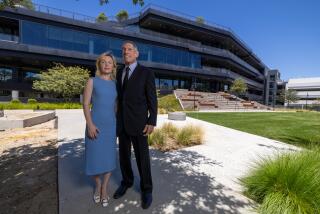Remastered version of a classic
With a rich history and a promising future, the University of Southern Californiaâs School of Cinematic Arts will celebrate its 80th birthday Sunday with a dedication ceremony of its new $175-million home on campus.
The schoolâs most famous alum, âStar Warsâ creator George Lucas, whose Lucasfilm Foundation provided $75 million for the new digs, plus $100 million for the schoolâs endowment, will be on hand. Steven Spielberg and Jeffrey Katzenberg are also scheduled to participate in the festivities.
Only two of the new facilities -- the George Lucas and Steven Spielberg buildings -- are actually completed and occupied. The Animation & Digital Arts building and three production buildings, which will house four sound stages as well as production services, are under construction and are set to open in 2010. Other studios have donated money as well, including Warner Bros., 20th Century Fox and Disney, but the school needs to raise an additional $50 million.
Lucas recalled in a recent interview that when he attended USC in the 1960s, ânobody from a film school in the United States had ever worked in the film industry. If you went to film school it was a silly thing to do because you would never get a job. Only people who ended up there were people who loved movies. So there was this underground movement of film nerds who werenât going to amount to anything. As far as we knew the studios didnât know we existed.â
Because the schoolâs thousands of alumni feature some of the biggest movers and shakers in Hollywood -- among them Robert Zemeckis, Bryan Singer and Ron Howard -- Cinematic Arts Dean Elizabeth M. Daley says people think the school is overflowing with money. But thatâs not the case. âSomething like 70% of our students are on financial aid,â she says. âWe count the paper clips around here. We were far under-budgeted, and we are still playing catch up.â
The schoolâs two newly opened structures have a combined space of 137,000 square feet with 10 classrooms, 19 conference rooms, eight screening rooms, six editorial labs, three mixing rooms, nine sound editorial rooms, a foley stage, ADR stage and three picture editorial rooms. Though all the digital equipment inside is cutting-edge, architecturally the buildings are modeled on the Hollywood of the 1920s. A statue of silent film superstar Douglas Fairbanks, who was involved in the founding of the school, is prominently on display in the Spanish-style courtyard. Fairbanks also taught at the school, which had been created as a joint venture with the then-fledgling Academy of Motion Picture Arts and Sciences. Other early faculty members included D.W. Griffith, Ernst Lubitsch and Irving Thalberg.
âI was never happy with the first [Lucas] building architecturally,â says Lucas. âI am sort of an architectural hobbyist, and for an artistic humanities kind of school, it didnât really look like what it was. My feeling was that we needed to infuse some of the history of the school into the environment, which is where the idea of making it look like it was made in 1929 and putting the founder in the middle of the school came from.
âThe phenomenon of this school is that it was started so close to the very, very beginning and that a lot of the real pioneers and heavyweights who made the film industry made the school. I took classes from John Ford. Hollywood is an important part of America and an important part of our culture.â
Lucas felt the time was right to expand the schoolâs reach. âThis is the time to embrace Hollywood and embrace our tradition,â Lucas says. âYou really have to know whatâs come before you in order to have a sophisticated view of where you are going in the future.â
The one prerequisite a cinema student needs is a passion for film, says Lucas.
âIt was the âgo-goâ â80s where students thought they were going to get rich in the film industry and going to film schools,â says Lucas. âI told the students then and I tell them now, if you are here to make money, youâre in the wrong place. This is the place you donât want to go make money. Very few people are successful at it. You better love making movies because if you donât you will live a very miserable life. Itâs definitely a hard physical and mental process that you go through. â
--







